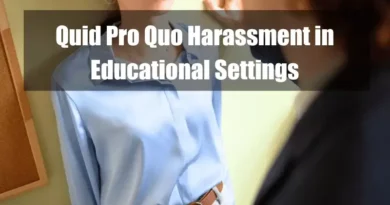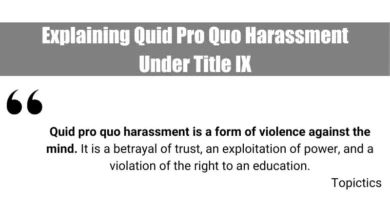Ways to Prevent Quid Pro Quo Harassment Under Title IX
Takeaways
| Key Points |
|---|
| Educational institutions must implement clear and comprehensive policies to prevent quid pro quo harassment under Title IX by defining the term explicitly, outlining acceptable behavior, and specifying disciplinary consequences for violations. |
| Regular training for students, faculty, and staff—including interactive and scenario-based programs—ensures ongoing awareness, while updating training materials keeps policies aligned with evolving regulations. |
| A culture of respect and reporting is essential, requiring schools to encourage reporting, protect anonymity, and provide multiple accessible reporting mechanisms, including online and offline options. |
| Title IX coordinators must be well-trained, accessible, and equipped with necessary resources to manage investigations transparently, ensuring impartiality, fairness, and regular updates to involved parties. |
| Institutions must also evaluate their prevention efforts through policy reviews and community feedback, provide victim support services such as counseling and accommodations, promote bystander intervention strategies, enforce accountability through consistent disciplinary actions, and engage the community in ongoing prevention initiatives to foster a safe and respectful learning environment. |
Introduction
Quid pro quo harassment, defined under Title IX, is a form of sexual harassment where submission to or rejection of unwelcome sexual conduct is used as a basis for decisions affecting an individual’s education or employment.
Title IX, a federal civil rights law enacted in 1972, prohibits sex-based discrimination in any educational program or activity receiving federal financial assistance.
Preventing Quid Pro Quo harassment under Title IX is essential for maintaining safe and inclusive educational environments.
Implementing Clear and Comprehensive Policies
Define Quid Pro Quo Harassment Under Title IX
Institutions must first provide a clear definition to prevent quid pro quo harassment. According to Title IX guidelines, quid pro quo harassment occurs when a person in authority requests sexual favors in exchange for benefits such as grades, promotions, or employment opportunities. Clearly defining this term in institutional policies helps set expectations for behavior and clarifies what constitutes a violation.
Establish Clear Guidelines For Acceptable Behavior
Educational institutions should establish detailed guidelines for acceptable behavior. These guidelines should specify what is considered inappropriate conduct and outline the boundaries of professional relationships.
Schools and universities should ensure that all community members understand these expectations by disseminating the policies widely, including in student handbooks and employee manuals.
Outline Consequences For Violations
It is crucial to communicate the consequences of violating quid pro quo harassment policies. Institutions must outline disciplinary actions, which can range from warnings to dismissal, depending on the severity of the offense.
This clarity serves as a deterrent and emphasizes the institution’s commitment to upholding Title IX standards.
Regular Training and Education Programs
Conduct Mandatory Training For Students, Faculty, and Staff
Regular training is a critical component of preventing quid pro quo harassment. All students, faculty, and staff should participate in mandatory training sessions that explain what constitutes harassment, how to report it, and the consequences of engaging in such behavior.
Training should be provided at the beginning of each academic year and repeated periodically to ensure ongoing awareness and compliance.
Use Interactive and Scenario-based Training
Interactive and scenario-based training can be more effective than traditional lecture formats. By engaging participants in real-life scenarios, they can better understand the nuances of quid pro quo harassment and how to respond to it. This method helps reinforce the training material and makes it more memorable.
Update Training Materials Regularly
As laws and policies related to Title IX evolve, so too should the training materials. Institutions should regularly update their training content to align with the latest legal requirements and best practices.
This proactive approach helps prevent harassment by ensuring everyone knows their rights and responsibilities under current regulations.
Encouraging a Culture of Respect and Reporting
Promote a Respectful and Inclusive Environment
Creating a culture of respect and inclusivity is essential in preventing quid pro quo harassment. Schools should promote mutual respect, equality, and professionalism in all interactions. This can be achieved through campaigns, workshops, and other initiatives highlighting the importance of a safe learning environment.
Encourage Reporting
Institutions must encourage reporting to address quid pro quo harassment effectively. They should ensure that all reports are taken seriously and investigated promptly. By fostering an environment where individuals feel safe coming forward, schools can better identify and address harassment issues.
Ensure Anonymity and Protection against Retaliation
Fear of retaliation can prevent individuals from reporting harassment. Institutions should establish policies that protect reporters’ anonymity and prohibit retaliation against them.
This ensures that individuals feel safe and supported when reporting incidents of harassment.
Creating Accessible Reporting Mechanisms
Provide Multiple Channels for Reporting Harassment
Having multiple reporting channels is vital for accessibility. Institutions should offer formal and informal reporting avenues, such as online reporting forms, hotlines, and in-person reports to designated officials. This flexibility allows individuals to choose the method they are most comfortable with.
Ensure These Channels are Accessible to All Students and Staff
Reporting mechanisms should be accessible to everyone, regardless of their role within the institution. This includes ensuring that reporting channels are available in multiple languages, accessible to individuals with disabilities, and open to part-time or remote employees.
Offer Online and Offline Reporting Options
Institutions should provide online and offline reporting options to accommodate different needs and preferences. Online forms should be secure and confidential, while offline options include speaking directly with a Title IX coordinator or another trusted official.
Appointing and Training Title IX Coordinators
Clearly Define the Role and Responsibilities of Title IX Coordinators
Title IX coordinators are vital in ensuring compliance with Title IX regulations and handling harassment cases, including quid pro quo harassment. Institutions must clearly define the role and responsibilities of these coordinators to manage complaints and support victims effectively. Their primary duties include overseeing the implementation of Title IX policies, coordinating training sessions, receiving and investigating complaints, and ensuring compliance with federal regulations.
Clearly defining these roles ensures that coordinators are prepared to handle incidents appropriately and consistently.
Ensure Coordinators are Well-trained and Accessible
To be effective, Title IX coordinators must receive comprehensive training that covers all aspects of their role, including understanding Title IX regulations, recognizing different forms of harassment, conducting investigations, and providing support to victims.
Coordinators should be accessible to the entire campus community through multiple communication channels, such as email, phone, or in-person meetings. An accessible coordinator helps build trust within the community, making it more likely that individuals will report incidents of harassment.
Equip Coordinators With the Necessary Tools and Support
Title IX coordinators require the proper tools and support to manage reports efficiently. This includes access to legal resources, training on handling trauma-informed interviews, and administrative support for managing investigations. Coordinators should also have access to software and databases that help track complaints, manage case files, and communicate with involved parties.
By equipping coordinators with these tools, institutions can ensure that reports are handled swiftly and accurately.
Conducting Prompt and Fair Investigations
Develop A Transparent Process for Investigating Complaints
A transparent investigation process is essential for maintaining trust in the institution’s handling of harassment complaints. The process should be documented and accessible to all community members, outlining each step from the initial report to the final resolution.
This transparency helps all parties understand what to expect and ensures the process is followed consistently for every case.
Ensure Impartiality and Fairness
Impartiality is crucial in conducting fair investigations. Investigators should have no personal or professional connections to the parties involved and should approach each case objectively.
Providing bias training and regular evaluations of the investigation process helps maintain fairness and impartiality. Ensuring that both the complainant and the respondent are treated with respect and given equal opportunities to present their case is key to a fair process.
Provide Regular Updates to Involved Parties
Keeping the involved parties informed throughout the investigation helps build trust and reduces anxiety. Institutions should establish a protocol for regular updates, including timelines for each investigation stage and the expected duration.
Clear and concise communication ensures that both parties understand the process and their rights, demonstrating the institution’s commitment to transparency and fairness.
Monitoring and Evaluating Prevention Efforts
Regularly Review the Effectiveness of Policies and Training
Continuous evaluation of policies and training programs is essential to ensure they effectively prevent quid pro quo harassment. Institutions should establish a regular review schedule to assess whether current policies are working as intended and make necessary adjustments.
This review should consider feedback from the community, changes in federal regulations, and new developments in best practices for harassment prevention.
Collect Feedback From Students, Faculty, and Staff
Gathering feedback from the entire community helps institutions understand the effectiveness of their prevention efforts. Surveys, focus groups, and anonymous feedback channels can provide valuable insights into how policies and training are perceived and where improvements are needed.
Engaging the community in this way helps refine prevention strategies and fosters a culture of openness and continuous improvement.
Make Necessary Adjustments Based on Feedback and Changes in Laws
Institutions must be prepared to adjust their policies and training programs based on the feedback collected and any updates to Title IX regulations. This might involve revising harassment definitions, updating training materials, or changing reporting procedures.
Staying responsive to internal feedback and external legal developments ensures that prevention efforts remain effective and relevant.
Providing Support and Resources for Victims
Offer Counseling and Support Services For Victims of Harassment
Providing comprehensive support services is crucial for helping harassment victims recover and continue their education or work without further distress. Institutions should offer confidential counseling services provided by professionals trained in trauma-informed care.
These services should be available to all community members and easily accessible online and in person.
Ensure Victims are Aware of Their Rights Under Title IX
Victims of harassment must be fully informed of their rights under Title IX, including their right to report harassment, receive support and accommodations, and have a fair investigation. Institutions should provide clear and accessible information about these rights through various channels, such as websites, printed materials, and training sessions.
This knowledge empowers victims to take appropriate action and seek the support they need.
Provide Academic and Workplace Accommodations If Needed
Harassment victims may require academic or workplace accommodations to help them continue their education or work without further disruption. Accommodations include changes to class schedules, extended deadlines, or work-duty modifications.
Institutions should work closely with victims to identify their needs and provide appropriate accommodations, ensuring they can continue their studies or employment without additional stress.
Promoting Bystander Intervention
Train the Community
Bystander intervention is a powerful tool for preventing harassment. Training programs should teach students, faculty, and staff how to recognize potential harassment situations and intervene safely. This training can include role-playing scenarios, discussions about the impact of harassment, and strategies for intervening or seeking help.
By empowering the community to act as bystanders, institutions can create an environment where harassment is less likely.
Encourage Proactive Engagement
Institutions should encourage a culture of proactive engagement among bystanders. This involves fostering an environment where everyone feels responsible for preventing harassment and is willing to take action when they witness inappropriate behavior.
Regular reminders through posters, social media campaigns, and events can reinforce the importance of bystander intervention and encourage individuals to speak up.
Include Bystander Intervention in Regular Training Programs
To ensure that bystander intervention remains a priority, it should be included in all regular training programs. This can be done through dedicated sessions on bystander strategies or by integrating bystander intervention into broader training on Title IX and harassment prevention. Regularly revisiting the topic helps keep it in mind and reinforces the community’s commitment to preventing harassment.
Ensuring Accountability and Consequences
Hold Perpetrators Accountable
Holding perpetrators accountable is essential for maintaining the integrity of harassment prevention efforts. Institutions must have clear procedures for disciplining those who engage in quid pro quo harassment, with consequences that reflect the severity of the offense.
Disciplinary actions might include suspension, expulsion, or termination, depending on the circumstances. Consistent enforcement of these consequences strongly conveys that harassment will not be tolerated.
Communicate the Consequences of Quid Pro Quo Harassment Clearly
The community must be aware of the consequences of quid pro quo harassment. Institutions should communicate these consequences through policy documents, training sessions, and public statements. Transparency in this area helps deter potential perpetrators and reassures the community that harassment is taken seriously.
Ensure Consistent Enforcement of Policies
Consistency in enforcing harassment policies is crucial for their effectiveness. Institutions must ensure that all cases of quid pro quo harassment are handled according to established procedures, with no exceptions. Consistent enforcement helps build trust in the system and ensures all community members are treated fairly and equally under the law.
Engaging the Community in Prevention Efforts
Prevention strategies are most effective when developed with input from the entire community. Institutions should actively involve students, faculty, and staff in creating and refining policies and programs to prevent quid pro quo harassment. This can be done through committees, focus groups, or surveys, ensuring that the voices of all stakeholders are heard.
Workshops, discussions, and awareness campaigns are key tools in engaging the community in harassment prevention. These events provide opportunities for education, discussion, and collaboration, helping to build a shared understanding of the issues and the importance of prevention. Institutions should regularly host these events to keep the conversation going and maintain a strong focus on prevention.
Ultimately, preventing quid pro quo harassment requires a collective effort. Institutions should work to foster a sense of shared responsibility among all community members, emphasizing that everyone has a role to play in maintaining a safe and respectful environment. By encouraging collaboration and mutual support, institutions can create a culture where harassment is less likely to occur.
Conclusion
Preventing quid pro quo harassment under Title IX requires a comprehensive approach that includes clear policies, regular training, and a strong commitment to enforcement and support.
By implementing the strategies outlined in this article, institutions can create safer and more inclusive educational environments.
These efforts must be ongoing and continuously refined to meet the evolving needs of the community and the legal landscape. With dedication and collective effort, quid pro quo harassment can be effectively prevented, ensuring that all individuals can learn and work in a safe and supportive environment.
FAQ
How can educational institutions implement effective anti-harassment policies under Title IX?
Institutions should establish clear policies that define quid pro quo harassment, outline reporting procedures, and specify disciplinary actions. These policies must be widely disseminated and accessible to all educational community members to ensure comprehensive understanding and compliance.
What is the importance of regular Title IX training for faculty and staff?
Regular training equips faculty and staff with the knowledge to identify, prevent, and respond to quid pro quo harassment. It ensures they understand their responsibilities under Title IX and fosters a safe educational environment.
How can institutions create a culture that discourages quid pro quo harassment?
Promoting a culture of respect and accountability involves leadership commitment, open discussions about harassment, and encouraging bystander intervention. This proactive approach helps prevent inappropriate behavior before it occurs.
Why is it crucial to have multiple reporting channels for harassment complaints?
Providing various reporting avenues, such as online forms, hotlines, and designated personnel, ensures accessibility and confidentiality, encouraging victims to come forward without fear of retaliation.
How does appointing a dedicated Title IX coordinator help in preventing harassment?
A Title IX coordinator oversees compliance, manages investigations, and serves as a point of contact for individuals reporting harassment, ensuring timely and appropriate responses to allegations.
What role do monitoring and evaluation play in preventing quid pro quo harassment?
Regular assessments of policies and procedures help identify gaps and areas for improvement, ensuring that anti-harassment measures remain effective and up-to-date.
How can institutions support individuals who report quid pro quo harassment?
Providing resources such as counseling, academic accommodations, and protection from retaliation encourages reporting and supports victims throughout the investigation process.
Why is transparency important in handling harassment cases?
Transparent procedures build trust in the institution’s commitment to addressing harassment, ensuring that all parties understand the process and outcomes of investigations.
How can educational institutions ensure compliance with Title IX regulations?
Regularly reviewing and updating policies to align with federal guidelines, conducting training sessions, and maintaining thorough records demonstrate compliance and a commitment to preventing harassment.
What strategies can prevent quid pro quo harassment in educational settings?
Implementing clear policies, providing regular training, establishing multiple reporting channels, appointing a dedicated Title IX coordinator, and fostering a culture of respect are key strategies to prevent quid pro quo harassment.








